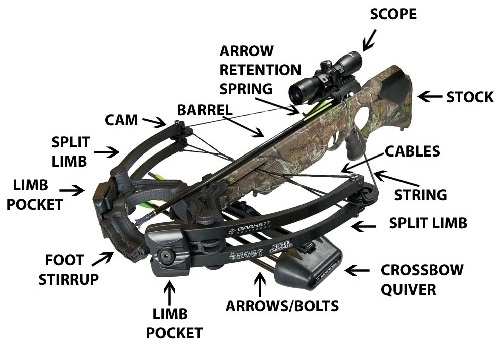The Barnett crossbow series is one of the most popular, and the reasons are apparent. They are cutting-edge crossbows that combine accuracy and precision with innovative technology.
If you’re a new archer or a professional, you must have come across these awesome Barnett Crossbows. These crossbows are exceptional pieces of instruments that offer fantastic features.
This article will show the diagram of the different components of a typical Barnett crossbow while discussing their functions.
Barnett Crossbow Parts Diagram
Barnett Crossbows are innovative equipment that breaks the rules. They shoot faster and sink deeper. There are different models, and certain ones are better for some situations. However, the components and designs are often similar. They share some common crucial parts. In the simplest form, the crossbows resemble a rifle but with a horizontal bow attached to the stock.
Below is a diagram showing the typical components of a Barnett Crossbow:
Barnett Crossbow Parts Explained
Learning about the parts that constitute the crossbow and how each component works will let you maintain the bow correctly. The proper maintenance of the crossbow will assist in achieving optimal performance.
A crossbow is a vertical bow attached horizontally to a frame, which uses a mechanism for holding the bowstring and then releases after to fire the crossbow.
Let’s discuss the function of the crucial parts of the crossbow.
Retention Spring
The retention spring is one of the most crucial components of the crossbow. Its responsibility is to hold the arrow in the track till the trigger prompts the latch mechanism. It’s a metal bar that holds the bolt until the trigger releases the latch. It helps keep the bolt from slipping away.
As such, the shooter can convey the crossbow easily from one location to another while keeping it cocked and ready to be fired. It’s usually designed with polymer and aluminum to improve its durability and reliability.
String
The function of the string in a crossbow can never be underestimated. It is an essential component that helps propel the bolt forward. The string influences the performance and the firing power of your crossbow.
It controls the feet per second(FPS) that the crossbow will launch a bolt. It’s often also designed with polyester fiber, natural fiber, and synthetic fiber. These materials are used because they have a high breaking point and stretch capability.
Stock
The stock is another critical component of the crossbow. It’s the portion away from danger points you hold when you shoot a bolt. It ties the trigger, barrel, and sight bridge together and acts as the crossbow’s operational base.
The stock rests against your shoulder when you’re using the crossbow. It’s typically made with wood or plastic.
Flight Groove
The Flight Groove is a grooved track on the crossbow barrel between the latch and bow. It serves a crucial purpose as it enables the arrow to sit in appropriate alignment with the string for enhanced accuracy every time the bolt is shot at the desired target. This component consists of different materials, but plastic and polymers are the most common.
Latch
Latch in crossbows is designed to hold the string when you cock the crossbow. It captures the string until you release the trigger.
Trigger
The crossbow trigger is what dispatches the string and fires the bolt. This mechanism is straightforward and uses two designs. The trigger is either situated under the latch attached behind the trigger or the latch holding the string in a cocked position.
Safety
The safety component ensures the arrow is not released inadvertently. It prevents the arrow from discharging accidentally. It may also engage automatically or manually when the crossbow is cocked. In some crossbow designs, there are dual safety systems.
Cocking Stirrup
The cocking stirrup is used to assist the cocking process in the crossbow. It is designed to accommodate the archer’s foot and ensure the bow doesn’t slip when cocked.
Riser
The Riser is the region in the crossbow where the limbs attach. It usually comes in different components but solely houses the bow limbs at a specific angle. In most cases, risers are built with machined or cast aluminum. However, some are made from magnesium and carbon.
Foregrip
The foregrip is the crossbow part where you rest your timing hands. It helps to give a more improved shot control so that you don’t fire aimlessly. The foregrip ensures your aim is steady and aligned with your desired target. In some crossbow designs, the foregrip is removable or collapsible.
Cams
Cams are the wheels attached to the end of each limb. The crossbow string is also connected to the cams. When you pull it back, the wheels will turn. As such, it saves a substantial amount of kinetic energy due to the limbs bending and then releases it once you pull the trigger.
Cables
Cables work together with the Cams. They are exclusively present only on compound crossbows. Their purpose is to reinforce the crossbow and adjust its firing force. They are similar to pulleys to keep the cable taut under the barrel when you pull the string back.
